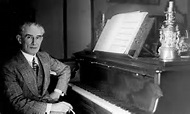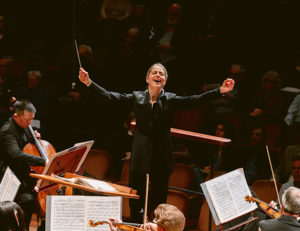The San Francisco Symphony demonstrated that making a program is an art in itself. On April 18, we saw and heard the SFS’ excellent sound conducted by the amazing Karina Canellakis. She is Chief Conductor of the Netherlands Radio Philharmonic Orchestra which she leads at the Amsterdam Concertgebouw and Utrecht’s TivoliVredenburg, She is also Principal Guest Conductor of the London Philharmonic. She comes on stage, promptly takes her place, and puts all her energy into conducting. She has a very physical style. One can remember that the sound is a real, physical thing when watching her bringing the orchestra forward with her arms upward, pulling them in. She has a great interaction with the musicians. Everyone levitates a bit off the stage floor; Ms Canellakis has an engaging, positive presence even during tragic music.
 Richard Strauss, composer, 1864-1949
Richard Strauss, composer, 1864-1949
The opening piece, Richard Strauss’ Don Juan, Opus 20 (1889) sounded wonderful. Those of us who do not find Don Juan to be a hero, still find the music made to accompany his triumphs outstanding. The Don Juan music was one of the symphonic poems Strauss created in the 1880s. The music represents Don Juan as an adventurer like the jovial Three Musketeers, a swashbuckling, devil-may-care kind of a guy. The music provides expressive moments when one could imagine him with a beloved and then turning to another. Only for a moment did I think, “Gee, here’s this wonderful woman conductor making Don Juan attractive through the music.” Then, the music ends the way it had to end: a father avenges the death of one of the women. Terrific music about a cheerful serial rapist. True to the spirit of another era.
 Maurice Ravel, composer, 1875-1937
Maurice Ravel, composer, 1875-1937
The Piano Concerto in D major for the Left Hand, by Maurice Ravel, is an extraordinary achievement even for a master like Ravel. However, it is a great work and not an oddity. It challenges the pianist’s and orchestra’s technique. It is beautiful, wholly original, and, I think has depths that one cannot anticipate while being mesmerized by the pianist’s one hand. The story behind this work is touching although the pianist and composer did not create a great friendship to match the great music. An Austrian family, Paul Wittgenstein was the brother of philosopher Ludwig Wittgenstein. Paul had begun a successful career as a pianist. Then, in World War I, he lost his right hand. it took a very long time to rehabilitate his injuries. Major composers wrote music for him: Hindemith, Korngold, Prokofiev, Britten, Strauss. it is Ravel’s that has lasted.
The pianist, Cedric Tiberghien, was brilliant and met every challenge without looking like he was climbing a mountain of difficult technique. Listen, but also see this music; it is very special, gorgeous, and moving.
Richard Strauss returned to the program with Death and Transfiguration, Opus 24. It was written 1888-1889. It was meant to be a symphonic poem, but there is no relation to a literary work. It is as though Strauss had a libretto running through his mind. He imagined a man who was very ill and in bed. While asleep he imagines or remembers moments of his life. He has a fever and pains. He was an artist. Strauss wrote,”the fruit of his path through life appears to him, the idea, the Ideal which he has tried to realize, to represent in his art, but which he has been unable to perfect because it was not for any human being to perfect it.” The moment of death comes, the music pictures his “soul leaves the body, in order to find perfected in the most glorious force in the eternal cosmos that which he could not fulfill here on earth.” This listener disliked the subject,fought it, the title, the music from its beginning. Then, without knowing why, this listener wept. A great composer can do that.
The program ended with La Valse, composed by Ravel, 1919-1920. it is a glamorous waltz at the beginning. Before the Great War, Ravel was fascinated by the Viennese waltz. He had plans for music saluting Johann Strauss II. The War changed everything including the waltz. It had been enjoyed in times of plenty; everyone in party dresses, the men smoking cigars, the women being elegantly flirty. Then, a generation of young men – French, English, German, all of Europe – were dead. They were missing legs, wearing terrible injuries, mentally different than before. La Valse presents all of this. Toward the end it goes faster and faster. I imagine an enormous chandelier suddenly crashing to the floor.
The SF Symphony met all the challenges of these great works with energy, precision, musicality. It was a brilliant evening we will be thinking about for a long time.
 Karina Canellakis, Conductor
Karina Canellakis, Conductor
